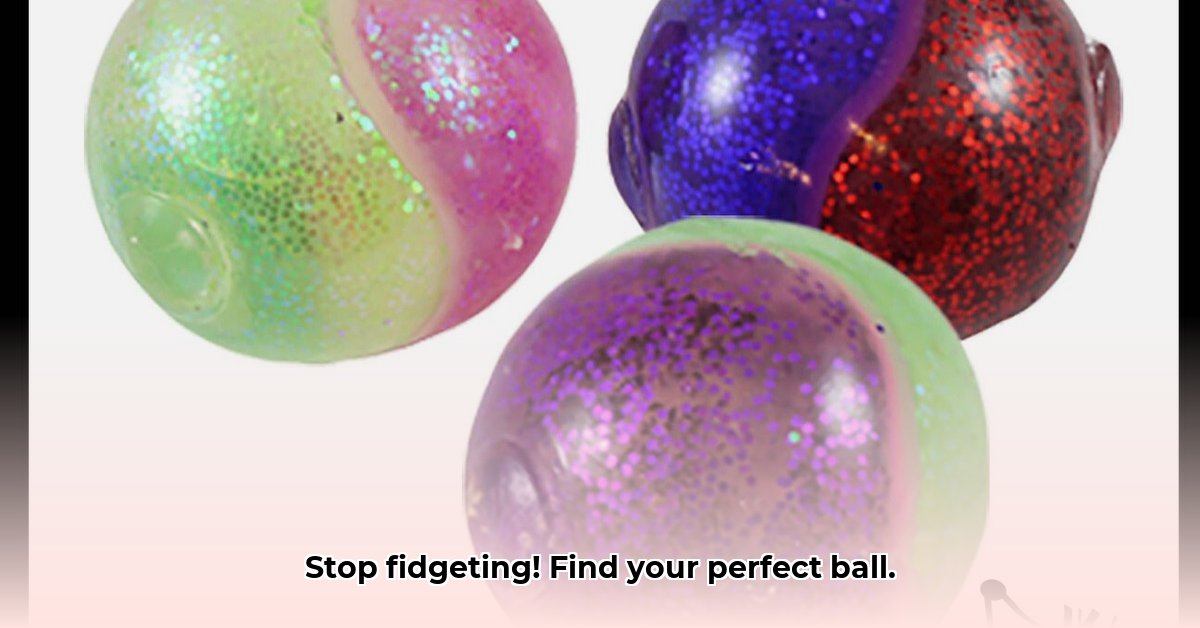Ever notice how many people are squeezing stress balls or twisting something in their hands? Fidget toys, especially fidget balls, are increasingly popular. They’re not just for kids; adults use them to manage stress, improve focus, and keep their hands busy. With so many options—different sizes, materials, and designs—finding the right one can be overwhelming. This guide cuts through the noise. We’ll explore the fidget ball market, examining popular choices and their benefits, and provide insights to help you choose the best one. Whether you need a personal stress reliever or are considering offering them to others, we’ve got you covered.
The Rise of Fidget Balls: Therapeutic Tools, Stress Relief, and Enhanced Focus
Fidget balls and sensory toys are more than just playthings; they are tools that help many individuals manage stress and enhance focus. These come in various forms – squishy silicone spheres, durable plastic gadgets, and even satisfying metal designs. The market offers numerous options, and navigating it can feel daunting. Let’s explore this world together.
A Deep Dive into the Fidget Ball Market
The fidget ball market is experiencing significant growth. While precise sales figures can be challenging to obtain, the variety of fidget balls available online and in stores indicates their widespread appeal. These products are available everywhere from major online marketplaces to local retailers. Marketing campaigns often emphasize stress relief and sensory integration, targeting adults who are seeking effective tools for anxiety management. This growth presents substantial opportunities for innovation and new designs within the fidget ball industry.
The Allure of Fidget Balls: Why They Work
The appeal of fidget balls is remarkably broad. Many people, both adults and children, find them beneficial. Adults can use fidget balls to relieve stress and anxiety by providing a discreet, tactile distraction that helps channel nervous energy. Children often use them to improve focus and concentration; the act of manipulating the ball can provide calming sensory input, helping them manage their energy and improve attention. Teachers find these tools useful in the classroom, offering a silent way to keep students’ hands occupied and their minds engaged. What makes the fidget ball universally appealing?
Determining if a Fidget Ball is Right for You
Before purchasing a fidget ball, consider your specific needs. Are you seeking stress relief, sensory integration, or improved focus? Do you prefer a soft, squishy feel or something firmer? Answering these questions will significantly narrow your choices and guide you to the perfect product.
Step-by-Step Guide to Finding Your Ideal Fidget Ball
Finding the right fidget ball involves thoughtful consideration and self-awareness. Here’s a simple guide:
- Define Your Objective: Are you primarily aiming to alleviate stress, boost focus, or simply have something enjoyable to play with? This will guide your entire selection process.
- Material Considerations: Explore common materials such as silicone (soft and squishy, ideal for stress relief), hard plastic (durable with diverse designs), and metal (weighted for enhanced sensory feedback). Each material offers a unique tactile experience.
- Size and Form: Decide based on your personal grip preferences. Smaller balls are excellent for portability, while larger ones provide more substantial tactile feedback.
- Additional Features: Consider features such as embedded beads, textured surfaces, pleasant scents, or even light-up components to enrich sensory input.
- Review Analysis: Before making a purchase, read customer reviews to gain insights into product quality and effectiveness.
- Smart Shopping: Choose reputable retailers to ensure better quality and minimize the risk of receiving a defective product.
Material Matters: A Comparative Analysis of Fidget Ball Materials
Your choice of material significantly influences the overall fidgeting experience. Here’s a detailed breakdown:
| Material | Pros | Cons |
|---|---|---|
| Silicone | Soft, pliable, easy to clean, widely available, hypoallergenic, non-toxic, and provides a good grip. Offers a soothing, squishy feel that is perfect for stress relief and sensory play. | Can attract dust and lint easily, may degrade with prolonged use, and some individuals may find the texture too sticky or rubbery. |
| Hard Plastic | Durable, resistant to damage, available in a wide variety of designs and colors, lightweight, and often less expensive than other materials. Ideal for fidgeters who prefer a solid and firm feel. | Can feel less comfortable or less sensory-satisfying to some users, may produce noise during use, and can be prone to cracking or breaking under significant pressure. |
| Metal | Durable, weighted, provides a distinct tactile feel, often gives a premium aesthetic, and can offer a cooling sensation. Ideal for those seeking a more substantial and grounding sensory experience. | Typically heavier than other options, potentially less portable, can become cold to the touch in colder environments, may be more expensive, and can pose a risk of scratching surfaces. |
| Rubber | Offers a classic bouncy feel, durable, provides good grip, and is available in a range of densities from soft to firm. Suitable for individuals who enjoy a resilient and flexible texture. | Can have a rubbery odor, may degrade over time with exposure to UV light, and can be less hygienic than silicone if not cleaned regularly. |
| Fabric-Covered | Provides a soft, comforting texture, can be filled with various materials for added tactile stimulation, and comes in a wide array of colors and patterns. Good for individuals who prefer a gentle and warm sensory experience. | Can be more difficult to clean, may absorb moisture and odors, and the fabric can fray or tear with heavy use, particularly if seams are not well-constructed. Filling materials could potentially leak if the fabric is damaged. |
Potential Downsides and Responsible Fidgeting
While fidget balls offer numerous benefits, it’s crucial to be aware of potential drawbacks. Small parts can be a choking hazard for young children, so constant supervision is necessary. Excessive use may also lead to repetitive strain injuries. How can you use a fidget ball safely and effectively?
The Future of Fidgeting: Emerging Trends and Innovative Designs
The fidget ball market is constantly evolving, with new materials, designs, and features appearing regularly. Future innovations will likely include more advanced fidget tools designed to alleviate anxiety, improve focus, and add a bit of enjoyment to your day. Stay informed about the latest developments in the fascinating and ever-changing world of fidget balls!
Selecting the Best Fidget Ball for Anxiety Relief
Key Points:
- Fidget balls can effectively manage anxiety.
- Success varies based on individual preferences.
- Material and size significantly influence the effectiveness of a fidget ball.
- Fidget balls are a supportive tool and not a substitute for professional mental health care.
Understanding the Fidget Ball Phenomenon
Do you often experience restlessness or a constant sense of anxiety? Many individuals find relief through fidget toys. Fidget balls are becoming increasingly popular as tools for managing anxiety and enhancing sensory input.
Diversity in Fidget Balls: Exploring the Options
The market offers a wide variety of fidget balls, including those made from silicone, rubber, and metal, as well as those that incorporate lights or sounds. Some are small and discreet, ideal for carrying in a pocket, while others are larger and provide more tactile feedback. Consider your sensory preferences to find the best option.
Tailoring to Your Needs: Practical Advice
Before making a purchase, consider the following:
- Usage Environment: Choose a small, quiet ball for work and a larger one for home use.
- Type of Anxiety: Determine if the fidget ball is for general anxiety or a more specific condition.
- Sensory Preferences: Consider whether you respond better to visual, auditory, or tactile stimulation.
Advantages and Disadvantages of Fidget Balls
| Pros | Cons |
|---|---|
| Provides a discreet and socially acceptable way to manage anxiety, offers tactile stimulation and sensory input, can improve focus and reduce restlessness, portable and easy to use. | May not be effective for all types of anxiety, potential for overuse or distraction, not a substitute for professional treatment, may not be suitable for all environments. |
| Can be a cost-effective tool for managing mild to moderate anxiety, helps occupy hands and mind, reducing the likelihood of compulsive behaviors, easy to integrate into daily routines. | Possibility to become reliant on the fidget ball, leading to increased anxiety when it’s not available, may draw unwanted attention in certain settings, potential for breakage. |
| Can be used in conjunction with other therapeutic techniques like deep breathing or mindfulness exercises to enhance their effectiveness, available in a wide range of textures and resistances. | Risk of developing a subconscious habit, making it difficult to stop fidgeting even when it’s not needed, might be perceived as unprofessional in certain settings. |
Selecting a Trustworthy Seller
Reputable sellers prioritize product quality and safety. Review online customer feedback before making a purchase. Look for sellers who provide comprehensive details about the materials used and offer responsive customer service.
Responsible Use and Potential Pitfalls
While fidget balls can be extremely beneficial, overuse can lead to distraction or increased anxiety. Remember
- Gluten Free Meal Prep Ideas for Delicious, Hassle-Free Eating - November 28, 2025
- Gluten Free Meal Prep for Stress-Free and Healthy Eating - November 27, 2025
- Quick And Easy Chicken Thigh Meal Prep For Weight Loss - November 26, 2025










